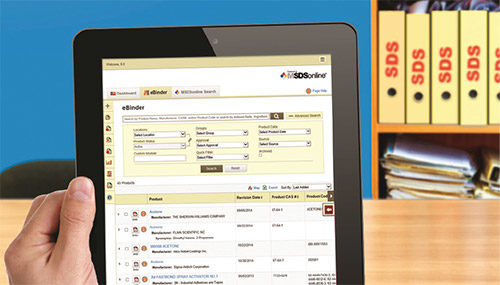Safety Data Sheets: Your responsibilities
What are the necessary steps to take if I receive a shipment without a Safety Data Sheet?

Responding is Glenn Trout, president and CEO, MSDSonline, Chicago.
As a safety professional, it is your job to ensure Safety Data Sheets are readily available to employees in a timely manner. That means you’re responsible not only for capturing SDSs as they enter your facility, but also for making sure these documents are properly cataloged and accessible to employees as well.
If you receive a shipment without an SDS, your first step should be to check your SDS library to see if it might already be logged. Chemical manufacturers and distributors are required to send an SDS only:
- With the first shipment
- With the first shipment after a significant change has been made, like an update to the new Globally Harmonized System of Classification and Labeling (GHS) format
- Upon request of the downstream user
If you don’t have the most current SDS in your library for a chemical you use or store in your facility, the onus then falls on you to secure it.
Many manufacturers and distributors missed the June 1, 2015, GHS deadline – the date by which upstream suppliers of hazardous chemicals needed to begin providing downstream receivers with SDSs in the new GHS format. This has created a lag in the distribution of updated SDSs in the GHS format throughout the chemical pipeline. Nevertheless, every chemical in your facility requires an SDS, even if the updated GHS formatted version isn’t available. If you need an SDS, the next step is to contact the manufacturer, distributor or importer to secure the most up-to-date document. If you are unable to secure the SDS, keep a record of your attempts to obtain it and contact your local OSHA office for assistance.
Make sure that all employees located on the front lines of chemical receiving – that includes dock workers and folks in procurement – are on the watch for new SDSs. These employees should know how to identify SDSs in the GHS format. This may require additional training for employees not already trained on hazard communication. A cloud-based SDS management system can help streamline this process by automatically locating and securing updated SDSs, and making them available to employees in real time.
Note: An important requirement of your written hazard communication plan is designating the employee(s) responsible for updating and managing SDSs at your facility. This person should not only catalog updated documents as they arrive, but also compare new SDSs to older versions to identify any new hazards that employees may need to be trained on. Under hazcom requirements, employees need to have a solid understanding of any new hazards listed on the updated SDSs that arrive to your facility.
With GHS in full swing, you should expect to see many updated SDSs arriving at your facility over the next few months. Knowing the steps to take to locate an SDS, and setting up a process to track and collect those documents now, will lessen the risk of missing these updated documents down the line.
Editor's note: This article represents the independent views of the author and should not be construed as a National Safety Council endorsement.
Post a comment to this article
Safety+Health welcomes comments that promote respectful dialogue. Please stay on topic. Comments that contain personal attacks, profanity or abusive language – or those aggressively promoting products or services – will be removed. We reserve the right to determine which comments violate our comment policy. (Anonymous comments are welcome; merely skip the “name” field in the comment box. An email address is required but will not be included with your comment.)

